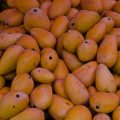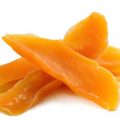Apart from their world-renowned hospitality, Filipinos are best known for their thriftiness. A plastic container previously holding your favorite ice cream will find its way to the dumpsite only if it has been reused more than twice (i.e., as ulam container in your fridge then as a tool organizer on your home desk). Filipino pork dishes, such as pork sisig, are made from pig’s ears and cheeks – animal parts usually ignored by other cultures. These are testament to the Filipinos’ tendency of not letting anything go to waste. Such can also be the case for mangoes – turning its waste to the country’s advantage.

The Philippines is blessed with several varieties of mangoes as the country is one of the Asian countries where mangoes are endemic and well regarded. Mango is even a national fruit to three countries, namely, Pakistan, India and the Philippines. Manggang kalabaw (Carabao mango or Champagne mango) is the biggest among the local varieties, and is often referred to as the “Manila super mango” which is recognized in the Guinness Book of World Records to be the sweetest mango in the world. The so-called “Indian mango” (katchamita) is another variety found here, smaller than manggang kalabaw and is also less sour when unripe, and less sweet when ripened. There are also the piko (pico) and pahutan varieties found all over the country. All varieties can be eaten unripe when its flesh is green to almost-white and very sour (manggang hilaw) along with bagoong (shrimp paste) or consumed when the fruit has ripened to a bright yellow-orangey color and at its sweetest phase, needing only a spoon to scoop out the flesh.
An abundance in mango supply leads to greater revenues for the country. Since numerous provinces in the archipelago produce mangoes, the country is able to supply its own needs with export produce to spare, and stands as the seventh top mango producer in the world. Forty-eight countries receive Philippine mangoes with fresh mangoes accounting for 59 percent of the total mango export. Of the remainder, 18 percent counts as mango puree, 16 percent dried as mangoes, and seven percent as juice. Producers include Davao, Cotabato, Sultan Kudarat, General Santos, Ilocos region, Misamis Oriental, Sarangani, and Cebu; with top production coming from Zamboanga del Norte, Negros Occidental, Pangasinan, and Guimaras.
Through the Department of Agriculture (DA) High Value Crops Development Program (HVCDP), efforts are being directed towards sustaining the supply of mango for export. This year alone, P15 million has been allotted for seedling distribution, post-harvest machine supply, and capacity building to be led by the Philippine Mango Industry Foundation, Inc. and this is just for one institution. Grants and funds shall be given to other agencies and organizations for other initiatives designed to increase and sustain mango production in the country.
However, production is not the only concern of the mango industry. With only 10 percent of the total mango production being exported, this means that 90 percent of our total production remains in the country for local consumption. Forty-one percent of the mango supply left in the country is used to produce value-added mango products. This means that a lot of mango waste from processing is being amassed in the country. Presently, an average of five truckloads a day of mango waste materials from mango processors alone is disposed of in dumpsites around the Philippines. This includes the mango peelings and seeds. Combined with other crop wastes, they become part of the mountains of garbage that plague the nation today.
Mango Waste as Pectin Source
In the Philippines, pectin is supplied through importation as both the raw materials (from apple and citrus peels) and the technology is not available in the country. According to the Department of Trade and Industry (DTI), in 2011, imports of pectin amounted to a little over P2 billion to supply the total pectin needs of pharmaceutical, cosmetics, and food processing industries.
Pectin is derived from the Greek word meaning “congealed or curdled” and is found in plants. It is used mainly as a gelling or thickening agent in numerous food (jams and jellies) and pharmaceutical products (as a source of dietary fiber). It is derived from fruits, chiefly from apples followed by citrus fruits.
During the 24th National Research Symposium, a paper titled, “Utilization of Mango Peels as Source of Pectin” by by Ma. Cristina B. Gragasin, Aileen R. Ligisan, Rosalinda C. Torres, and Romulo R. Estrella of the Department of Agriculture’s (DA) Philippine Center for Postharvest Development and Mechanization (PhilMech) and the Department of Science and Technology –Industrial Technology Development Institute (DOST-ITDI), was awarded first place (Gold award) in the applied research (technology/information) category. The study aims to utilize mango peels that are otherwise considered waste as a source of pectin, allowing the country to potentially produce its own pectin to meet national demand. Effective utilization of mango waste also means less material in dumpsites and less environmental issues.
In the study, Gragasin evaluated the pectin quality harvested from our native carabao mango (Mangifera indica) with reference to the United States Pharmacopeia (USP) specifications for pharmaceutical-grade pectin. According to her, now that we have determined that carabao mango peels could be a source of USP-standard pectin, we will not only be able to focus our resources on developing Philippine-produced pectin from mango peels, but that we will be able to generate income-generating jobs and minimize solid waste materials.
The paper further reveals that “the volume of mango peels needed to produce the total volume of the country’s pectin importation, which amounted to 94,849 kg in 2011, can already be supplied with just two percent of the total mango peels wasted at the processors level.” This means that, with this new knowledge, we will not only fully meet the country’s pectin requirement but possibly produce for the foreign market as well.
R&D for E&E (Economy and Environment)
This study presents a three-pronged solution to three different but equally relevant issues in our time today: costly importation; lack of income-earning opportunities; and the eternal battle against waste management inadequacies which are all very heavy but, ultimately, solvable problems.
From mango peels, we can now extract pectin; thus, we are in a position to be self-sufficient in the product and stop the importation to meet local pectin demand. The tons of mango peels resting in mountains of waste products in dumpsites can be greatly reduced once it is realized that mango peel waste can now be utilized for profit. This study also promotes income opportunities for mango farmers as they will now be able to earn more from their produce which will not be limited to the fruits.
Mango peels that once lined the surfaces of the mountains of waste products could now be part of an income-generating process. We can turn to the mango peels that was once discarded and deemed valueless to supply our pectin demand, the importation of which cost us P2 billion last year, thus changing it from garbage to gold. ###
———-
For more details, please contact Ma. Cristina B. Gragasin, supervising science research specialist, PhilMech through email: cristygragasin@yahoo.com
Source: Zuellen B. Reynoso BAR Digest April-June 2013 Issue (Vol. 15 No.2)






Hello! San po kayo exactly kumuha ng exact data about the mango peels and seeds? Neede lang po for research project. Thank you po!
What is the source of this data, “An average of five truckloads a day of mango waste materials from mango processors alone is disposed of in dumpsites around the Philippines”?
Want part time or Full time job?? Work from the safety of your own home.
Email me at yhuan.flores@yahoo.com
For more details kindly visit www.unemployedpinoys.com